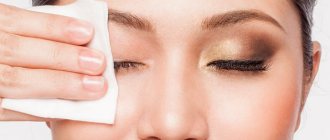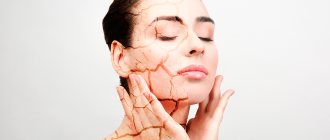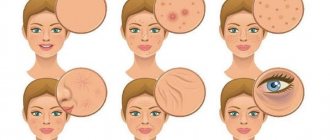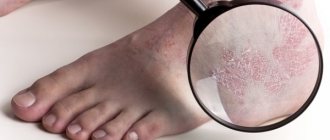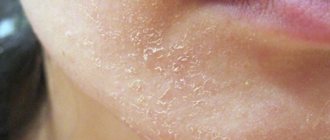How to diagnose the cause
It is impossible to understand what the reason is. Fungal infection and dryness, as a cosmetic defect, manifest themselves in the same way. You will feel itching, tightness, and flaky scales will appear on your hair.
Make an appointment with a trichologist. Using a special device, he will examine the scalp under high magnification, will be able to assess the condition, appearance, number of scales, and then draw conclusions. You may be prescribed additional tests to rule out deficiency conditions in a number of vitamins and microelements.
Types and symptoms
Let's consider what signs can be used to recognize peeling skin on the head at the initial stage.
In the human body, there is a constant renewal of cells in all organs, including the skin of the head. Therefore, their moderate rejection is a physiological process and should not cause concern. But if the scalp is too dry, itchy, very flaky, and scales are rejected, then there is a high probability of a fungal infection.
If this unpleasant phenomenon occurs, you should seek qualified medical help. The presence of a fungal disease or other disorder can be detected using laboratory tests.
Timely treatment can significantly improve the condition of the skin, it will stop itching and flaking.
After just two to three weeks, the white flakes on your hair will disappear.
How to treat
Regardless of the reason, special medicated shampoos with tar, zinc, selenium or ketoconazole are used. If the problem appears due to external or internal factors, there is a risk of a fungal infection. These components will slow down its development.
All shampoos that moisturize the scalp and are aimed at treatment contain one of the active ingredients. If a product with selenium does not work for you, you can try something else, for example, with zinc or tar. The reaction is very individual.
Main causes of peeling
The fungus can affect large areas of skin
The skin on the forehead most often peels due to nutritional deficiencies, hormonal imbalances and dermatological problems.
Skin diseases
Peeling on the forehead can appear due to fungal infections. Along with dryness, severe itching occurs.
Dermatitis and allergic reactions are also accompanied by itching and redness, but a rash is likely to occur. Peeling, formation of crusts and scales are possible with eczema and psoriasis.
There is a medical term for dry skin. This is xerosis - a condition of the dermis, which is accompanied by dryness, peeling, keratinization, and a feeling of tightness.
Lack of vitamins
Hypovitaminosis affects the skin of the face, nails and hair
Hypovitaminosis affects the condition of the skin, since the skin needs nutrition from the inside. With a deficiency of the most important nutrients, the skin on the forehead becomes dry and flaky not only in women, but also in men.
Most often, dry dermis is caused by a lack of retinol (vitamin A). It is responsible for hydration and protection from adverse environmental factors. In addition to peeling, when it is deficient, “crow’s feet” appear around the eyes.
The skin can also dry out if there is a deficiency of the following nutrients:
- Vitamin E. With its deficiency, the skin becomes dry, flabby, and undergoes premature aging.
- Vitamin B2. Its deficiency is accompanied by dryness, peeling of the dermis, and cracks may appear.
- Vitamin C. Necessary for the synthesis of collagen, which promotes the elasticity of the dermis and retains moisture inside.
- Omega-3. Helps the skin retain moisture and stay young.
In addition to nutrient deficiency, dry skin can be caused by insufficient drinking regimen.
Hormonal disorders of the body
Hormonal changes affect the condition of the skin. Under the influence of hormones, pigment spots, pimples, acne, as well as dryness and flaking appear.
During pregnancy and menopause, the lipid balance is disrupted, as a result the dermis becomes dehydrated, its protective properties decrease, which increases the risk of growth of pathogenic microflora. Dryness is also observed in hypothyroidism and other endocrine diseases.
Causes of peeling skin on the forehead of a baby
Seborrheic dermatitis in infants
If peeling appears at the temples or on the forehead closer to the hair, seborrheic dermatitis cannot be ruled out. But more often, dry skin in infants is caused by increased sensitivity of the dermis. Dry air and unfavorable weather conditions lead to peeling.
Dry skin in a newborn can be a sign of atopic dermatitis, diabetes mellitus, helminthic infestations and other health problems, so consultation with a pediatrician and dermatologist is required.
Causes of peeling skin under the eyebrows
Skin after sunburn
If an adult's forehead and eyebrows peel, this is a sign of improper skin care. Due to insufficient hydration and nutrition, the dermis begins to dry out. But there are other reasons for this problem:
- allergies to cosmetics, such as eyebrow dye;
- insufficient peeling, as a result of which dead cells are not removed;
- tanning abuse;
- deficiency of nutrients.
To avoid skin problems, it is important to pay attention to its nutrition and hydration.
How else can you moisturize your scalp: 7 ways
- For care, use moisturizing shampoos for dry scalps marked Sensitive (for sensitive types) or a sulfate-free product.
- Make masks, use serums or special cream. The simplest option: mix a regular conditioner or hair mask with any cosmetic oil (burdock, coconut, jojoba). Apply to your head under a towel or film for at least 30 minutes, maximum for a couple of hours. After washing off the mask with shampoo, apply conditioner.
- Don't forget to exfoliate regularly. Many people only think about how to moisturize dry scalp when flaking. But proper cleansing is no less important to solve the problem. But under no circumstances should you apply products with coarse abrasive particles to this area. They injure the delicate scalp and can damage hairs in the initial stages of growth. Acid peels, for example, with mandelic acid, are suitable for care. Apply them with rubbing movements throughout the scalp for 15 minutes, then rinse with shampoo. Do the procedure once a week.
- Buy pharmacy leave-in products with oils. The only “but” is that if you apply it after washing, your hair may look stale. Use before shampoo. Apply, rub in, leave for several hours. Then wash it off with shampoo.
- Take vitamins if the cause is vitamin deficiency. Even if it seems to you that all the signs of a deficiency of a particular vitamin are present, first consult a doctor and get a diagnosis. Then, if necessary, the doctor will select the appropriate dose of the required vitamin or microelement.
- Balance your diet. It must contain protein: plant and animal. Include different types of meat in your menu - this way you are more likely to gain the required amount of amino acids necessary for the construction of cells. If for some reason you do not consume animal protein, take amino acid supplements designed specifically for women. The doctor will select the appropriate ones; there should be no amateur activity. If the reason is the proliferation of a fungus, reduce the consumption of simple carbohydrates and spicy foods as much as possible.
- Pay attention to your drinking regime. None of the measures will work if the body experiences a lack of fluid. Drink the prescribed amount of water in small portions throughout the day.
Treatment
You can get rid of flaking of the scalp on your own only if it is not caused by a pathology. Then preventive measures and proper hair care are quite enough.
Masks prepared according to folk recipes also have a good effect. But if there are sores on your head, you should not do them under any circumstances. And you definitely need to find out why they appeared.
It is very useful for the scalp, and the condition of the entire hair, to regularly rinse it after washing with decoctions of herbs: chamomile, sage, coltsfoot, St. John's wort. This will nourish the hair follicles, moisturize and soothe the scalp, and prevent pathogenic bacteria from actively multiplying. Already two such rinses per week are quite enough to effectively prevent dandruff.
If you suspect a pathology, it is better to go to the doctor. He will prescribe treatment based on the results of the studies:
- infectious skin diseases are treated with antibiotic ointments, and in some cases additional oral administration may be required;
- fungal infections can be easily eliminated with the help of medicated antifungal shampoos, which must be used strictly according to the instructions;
- dry skin is removed with massages and masks, but they cannot be done if the integrity of the skin is damaged;
- the problem of vitamin deficiency is solved by correcting nutrition and taking high-quality multivitamins;
- endocrine disorders are the most difficult to correct and can often be done only with the help of hormone-containing drugs.
The medicinal ointment “Sulsena” has proven itself well, which can be bought without a prescription at any pharmacy.
The product is made on the basis of a compound of sulfur and selenium, but contains many other active ingredients: glycerin, citric acid, cinnamic alcohol, potassium phosphate. It regulates the functioning of the sebaceous glands, promotes the healing of microcracks, accelerates hair growth and quickly eliminates non-fungal dandruff.
Hypoallergenic paints
When dyeing your hair, you cannot be 100% sure that you will be able to avoid allergies. But with the right choice of paint, you can reduce its likelihood.
The most popular paints with a gentle composition:
- Wella Color. Ammonia-free. The dye contains nutritional components that have a beneficial effect on the skin and hair.
- SYOSS Professional. The composition of the paint does not dry out the skin and hair.
- Estel. Without ammonia, the paint is enriched with vitamins. Nourishes the skin and scalp. Reasonable price and high durability.
- L'Oreal. There is an ammonia-free series of this brand. The main disadvantage is that it doesn’t cover gray hair enough.
- Garnier-Color Naturals. Ammonia-free range. Permanent cream paint. Lots of natural shades.
- Matrix SOCOLOR beauty. Hypoallergenic paint. Among the disadvantages, low durability is noted, especially in red tones.
- Chi. The dye contains amino acids that nourish the skin and hair. It is characterized by increased durability.
There are no absolutely harmless paints. If a woman decides to dye her hair, then care should be taken to ensure that the dye causes minimal harm not only to the hair and scalp, but also to the body as a whole. To do this, you should buy products only from trusted brands, preferably in branded stores or contact professionals.
Another mandatory rule when painting at home is strict adherence to the rules set out in the attached instructions.
Ways to diagnose the problem
If you have problems with the scalp or the condition of the strands, you should contact a therapist, dermatologist, trichologist and infectious disease specialist.
The diagnosis is made based on interviewing the patient, identifying complaints, and visual examination of the scalp. To obtain the most accurate information, use a dermatoscope - a special device that allows you to examine a certain area of the skin in an enlarged form.
Laboratory tests also make it possible to clarify the reason why active peeling of the dermis occurs. These include a microscopic examination, the biological material for which is exfoliated scales or part of a broken hair, as well as a Wood's lamp test. The latest diagnostic method allows you to identify pathogenic microorganisms that caused the development of lichen on the scalp.
On this topic
- Diseases
All about dry seborrhea
- Irina Nasredinovna Nachoeva
- September 24, 2020
Wood's lamp is a tool used to identify affected areas of the dermis. It is a black light source designed using fluorescent, mercury vapor or light emitting lamps. It is under the influence of emitted black light that the epithelium in the affected areas glows.
The procedure is as follows:
- in a darkened office they turn on the device;
- light is directed to the area of skin that needs to be examined from a distance of about 10-30 cm;
- The fluorescent light detects the affected areas, causing them to glow a specific color.
The presence of epithelial pathologies is detected if the examined area glows blue-green or pale blue: this indicates the development of a fungal infection. If white-yellow spots appear, lichen planus is suspected.
Manifestation of an allergic reaction
Allergy symptoms may vary depending on personal intolerance to a particular component:
- itchy skin;
- swelling of the face, in especially severe cases - Quincke's edema;
- peeling of the skin;
- burning in areas where paint was applied;
- eye irritation, tearing;
- the appearance of irritation in the form of red spots, wounds;
- rashes from small pimples to large blisters not only on the scalp, but also on the face;
- runny nose.
It should be remembered that a reaction can occur not only during the staining period or immediately after it. Negative effects may appear even after two days. This makes it very difficult to diagnose and identify the allergen substance.
If there are wounds, irritations and other damage to the scalp, hair coloring should not be done.

